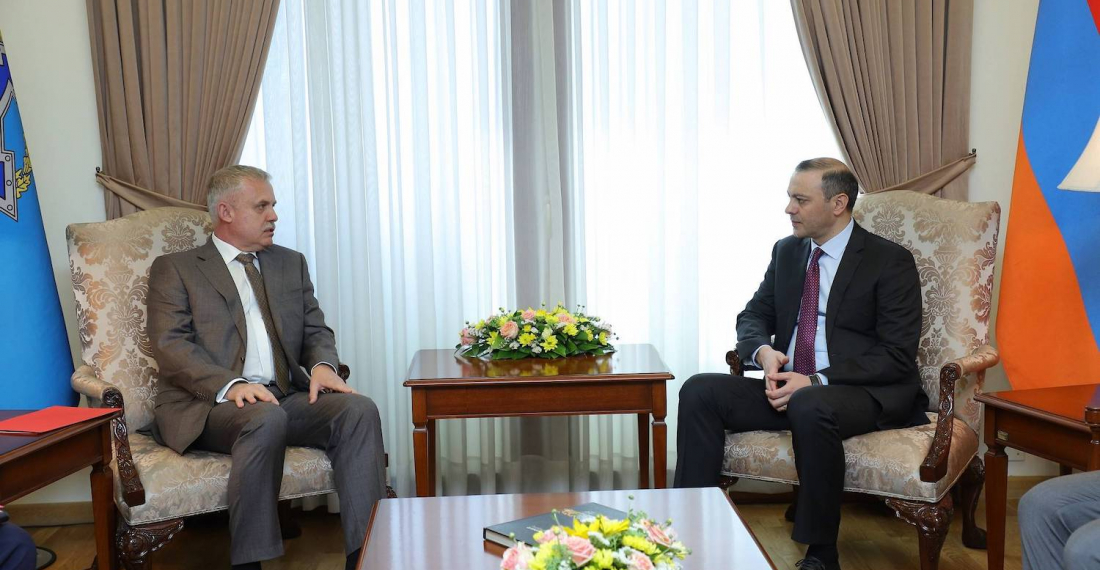The secretary-general of the Collective Security Treaty Organization (CSTO), Stanislas Zas, has arrived in Armenia for a working visit. He met separately today (9 July) with Armenia’s acting minister of foreign affairs, Armen Grigoryan, its minister of defence, Arshak Karapetyan, and the head of bureau of Armenia’s Security Council, Hayk Petrosyan.
A readout by the CSTO reports that in his meeting with Grigoryan, Zas highlighted multiple threats to the organisation’s ‘zone of responsibility’, outlining what he described as a combined attack on Belarus to overthrow its “legitimate government”; instability caused by the US withdrawal from Afghanistan providing dangers for the Central Asian countries; and the situation on the Armenian-Azerbaijani border, which affects the security of both Armenia and the CSTO area of responsibility as a whole. On the latter point, Zas expressed “serious concern”, whilst stating that “the possibilities of settling the border conflicts between Armenia and Azerbaijan by political and diplomatic measures are far from being exhausted”.
The Armenian readout from the meeting states that Grigoryan briefed Zas on the alleged infiltration of Azerbaijani armed forces into the Syunik and Gegharkunik regions, as well as what it refers to as ‘consistent provocations’ by Azerbaijan, including from its western exclave, Nakhchivan. Sharing assessments on the security situation in the CSTO’s zone of responsibility in the Caucasus, Grigoryan drew attention to the potential consequences and threats emanating from Turkish-Azerbaijani co-operation in Nagorno-Karabakh. The Armenian readout notes that the men agreed upon the need for de-escalation, emphasising the importance of settling the Nagorno-Karabakh conflict within the framework of the OSCE Minsk Group Co-Chairmanship – a detail omitted in the readout by the CSTO.
Grigoryan then discussed Armenia’s approach to its upcoming presidency of the CSTO, which will begin on 16 September. He stressed that his country’s focus will be on increasing the organisation’s efficiency and strengthening the mechanisms for responding to the needs of the member states in time.
In Zas’s meeting with Arshak Karapetyan, the CSTO reports that the men discussed the signing of four important documents during the next session of the Collective Security Council. These documents are said to include “changes to the Agreement on CSTO Peacekeeping Activities, which determine the procedure and the possibility of attracting the CSTO Peacekeeping Forces to UN peacekeeping missions through the “coordinating state”, as well as the Plan for equipping the CSTO Collective Rapid Reaction Forces (CRRF) with modern weapons, military and special equipment.” The men also reportedly discussed planned military exercises by the CSTO member states later this year in Tajikistan and Russia.
In Zas’s meeting with Hayk Petrosyan, the readout by the Armenian Security Council reports that the situation on the Armenian-Azerbaijani border was discussed, including the possibility of using existing mechanisms within the CSTO in the process of peacefully settling the situation. The CSTO readout mentions only the men discussing current issues and threats, and the forthcoming Thunder-2021 exercise in Armenia at the end of September with the special forces of the anti-drug services of the CSTO member states.
Zas’s trip to Armenia will continue tomorrow, when he is due to meet the prime minister of Armenia, Nikol Pashinyan.



